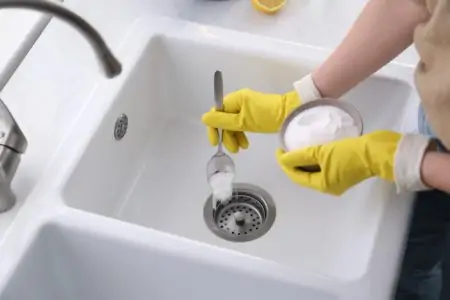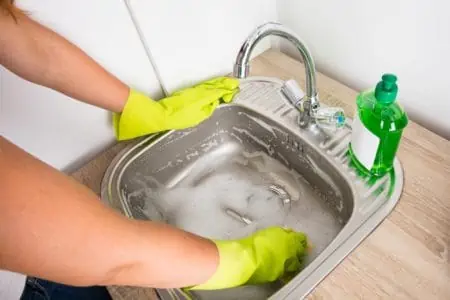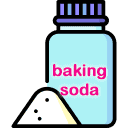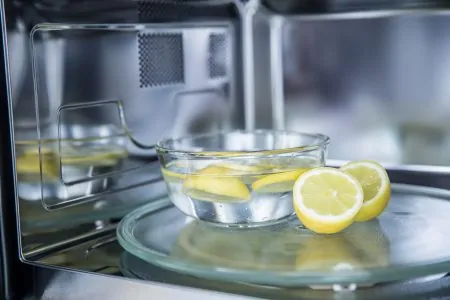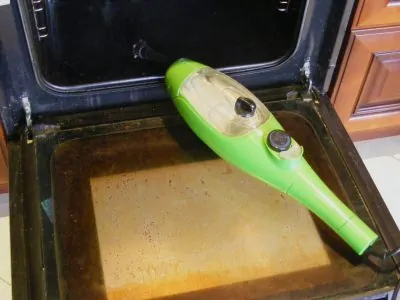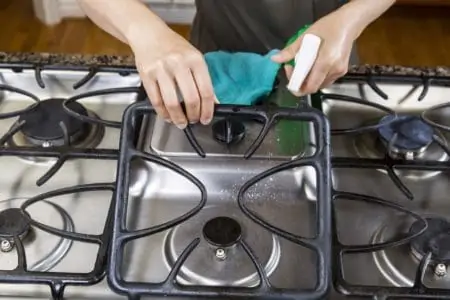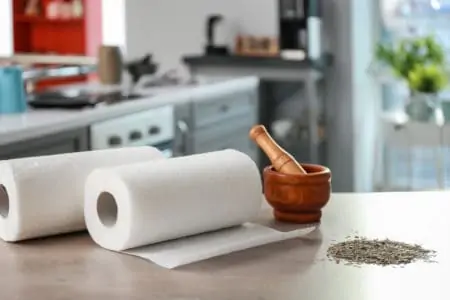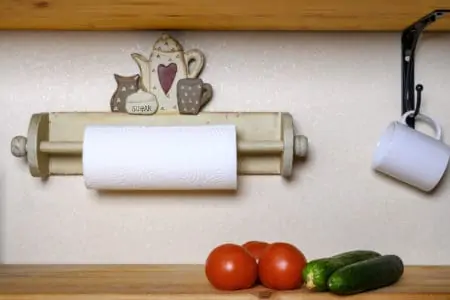Is your sink getting dirty or clogged causing it to not drain easily? Then you need to clean your sink. One excellent way to clean your sink naturally is to use baking soda instead of chemical cleaners.
Baking soda is a safe and natural mineral that is safe to keep in the house around small children and animals. Read on to learn both how to clean a sink with baking soda and how to clean a drain with baking soda and vinegar.
Key Takeaways
- Clean a sink with baking soda as a gentle abrasive that won’t scratch surfaces, even stainless steel.
- Clean drains with baking soda and vinegar monthly to keep sinks draining well and prevent clogs.
- Use a vinegar-soaked paper towel to sanitize sinks and faucets, removing hard water stains.
- Deodorize drains by pouring baking soda and vinegar, followed by hot water, to neutralize odors.
How Often to Clean Your Drains
The best way to keep your drains draining well is to clean them on a regular basis. This can be done on a weekly basis by pouring boiled water mixed with liquid grease-fighting dish soap down the drain. This should wash away any possible greasy suds left in your drain and prevent a blockage caused by build-up, to clog your drain.
If you notice that your drains are not draining well, immediately clean your drains with the homemade baking soda and vinegar recipe. You can do this once a month as part of your regular maintenance routine. This will help to keep your sinks draining well.
How To Clean Kitchen Sink With Baking Soda
- Time: 20 minutes
- Difficulty: Beginner
What You’ll Need
- Baking soda
- Dish soap
- Vinegar
- Measuring cups
- Sponge
- Paper towels
1. Thoroughly Rinse Your Sink
The first step is to thoroughly rinse your sink. You want to remove any grease or food particles sticking to the side of your sink. When you’re finished, empty your drain basket into the trash can.
2. Sprinkle The Sink With Baking Soda
Now sprinkle the sink with a good layer of baking soda and don’t be stingy. The baking soda will gently scrub your sink clean without damaging the finish.
3. Put Dish Soap on a Clean Sponge
After the sink is covered with baking soda, you’re almost ready to start scrubbing. First, put a small amount of dish soap on a clean sponge. This will make cleaning your sink easier.
4. Scrub The Sink From The Top Down
Scrub the sink from the top to the bottom using circular motions. You should end your scrubbing at the drain. Keep in mind that baking soda is a mild abrasive and will not damage your sink even if it’s stainless steel.
5. Rinse The Sink
When you’ve finished scrubbing your entire sink, it’s time to rinse your sink with water. Make sure that you’ve rinsed everything off your sink before you sanitize the sink with vinegar.
6. Sanitize With Vinegar
To sanitize your sink with vinegar, you will first soak some paper towels with vinegar and cover your sink with these paper towels. Let them sit for 20 minutes before you remove them.
Vinegar is a natural sanitizer and by leaving it on your sink you’re giving the vinegar a chance to sanitize it. In addition, vinegar will remove any hard water stains left on your sink.
7. Clean And Sanitize Faucets And Sink Handle
After the 20 minutes is over, clean your faucets and sink handle with some soapy water. Then rinse them clean with fresh water.
Afterward, put some vinegar on a clean cloth to wipe down the faucets and sink handle. This will sanitize them.
8. Rinse Thoroughly
Rinse your sink thoroughly when you’re finished. If you have a stainless steel sink, you can buff your sink with a paper towel and some olive oil. This will keep your sink shiny for weeks.
9. Deodorize the Disposal or Drain
To deodorize the disposal pour ½ a cup of baking soda down your drain. Turn on the garbage disposal for a few seconds.
Now add 1 cup of vinegar. Let everything fizz. When the fizzing stops, rinse with hot water then run the disposal for a few seconds to ensure that everything has been removed from it.
Deodorizing a drain is similar. First, pour a smaller amount of baking soda, about ⅓ cup, down your drain and follow with 1 cup of vinegar. Again, let everything fizz. When the fizzing stops, you can rinse the drain with hot water.
How To Clean a Clogged Drain With Vinegar And Baking Soda
- Time: 30 minutes
- Difficulty: Beginner
What You’ll Need
- Grease-fighting dish soap
- Baking soda
- White vinegar
- Measuring cups
- Kettle or large pourable measuring cup
1. Boil Water
To start, boil 6-8 cups of water.
2. Pour Boiling Water and Dish Soap Into Drain
Squirt some of your grease-fighting dish soap into your drain. Then slowly pour the boiling water down the drain. Be careful not to burn yourself when pouring. This DIY combination will help to remove any greasy clogs that may be in your sink.
3. Pour Baking Soda Into the Drain
Measure out 1 cup of baking soda. You need to pour the baking soda into the drain. A smaller drain will need a funnel to get the baking soda down it.
Or you can simply pour the baking soda directly into the drain from your measuring cup. Push any baking soda that falls into the sink into the drain with your fingers.
4. Pour One Cup of Distilled White Vinegar Into The Drain
Now it’s time to unclog your drain. Pour 1 cup of white vinegar into it. Don’t worry about any noise you hear, it’s the vinegar reacting with the baking soda which is what will clear your drain.
Cover your drain with a plug. It will create pressure in the closed drain that will help to remove the clog.
Leave the baking soda and vinegar in the drain for at least 10 minutes. Or you can wait until you no longer hear any fizzing from your sink. Then set the buzzer for 10 minutes.
You want to give the vinegar and baking soda plenty of time to work before flushing the drain, so waiting longer is better than flushing the drain too soon.
5. Flush With More Hot Water
To flush the drain with hot water, boil 2 cups of water and carefully pour it down your drain. If your drain is unclogged, run hot water down it for 3-4 minutes to help clear any residue lingering in the drain.
If the drain is still not draining, repeat these steps 2 or 3 times.
You may need to clean your drain with salt and baking soda if vinegar and baking soda are still aren’t working.
How to Clean a Clogged Drain With Salt and Baking Soda
- Time: Overnight
- Difficulty: Beginner
What You’ll Need
- Baking soda
- Salt
- Kettle or large pourable measuring cup
1. Pour Baking Soda Into the Drain
To start, pour 1 cup of baking soda into the drain. You may be able to pour the baking soda directly into the drain from the measuring cup or you may need to use a funnel if you have a small drain.
2. Pour Salt Into the Drain
Now pour ½ cup salt into the drain. You will need to let the baking soda and salt sit in the drain overnight or at least for a few hours.
3. Flush With Boiling Water
The next morning boil 2 cups of water and carefully pour the boiling water down your drain.
4. Flush With Tap Water
If the drain begins to drain, you can flush it with hot tap water for several minutes to make sure that you remove any residue in the drain.
If the drain is still clogged, repeat the steps once or twice. If that doesn’t work, you may need to disassemble the drain to remove the clog.
5 Expert Tips to Prevent Your Drain From Clogging
These simple hacks will help to prevent your drains from clogging, so you won’t need to purchase expensive chemicals to clean your kitchen sink drain.
1. No Coffee Grounds in the Sink
Do not put coffee grounds in the sink. Coffee grounds don’t break down when immersed in water. Instead, they clump together and will clog your sink.
2. Pour Hot Water Down Your Sink
Slowly pour a kettle of hot water down your drain once a week to melt any grease away. Be sure to pour the water slowly so that it doesn’t splash on you.
3. Never Pour Oil or Grease Down the Drain
Never pour oil or grease down your drain. Instead, keep an old can to pour the oil and grease into before you wash your pan. After the oil and grease have congealed, you can throw the can away.
4. Use a Paper Towel to Wipe Greasy Pans
Use a paper towel to wipe greasy pans before you wash them. This will remove large amounts of grease and prevent the grease from going down your drain and potentially clogging your drain.
5. Use Strainer Baskets
Add strainer baskets to all your drains to prevent food particles and hair from going down your drain and creating clogs.
FAQs About Cleaning The Sink
In Conclusion
First, empty your sink removing any dishes and food debris. Next, give your sink a quick wash and rinse. Sprinkle baking soda over your entire sink. Use a clean sponge with some dish soap to scrub the sink. Start at the top and work towards the drain. The baking soda is a gentle abrasive and will not scratch your sink, even if it is stainless steel. Finish by rinsing your sink.
